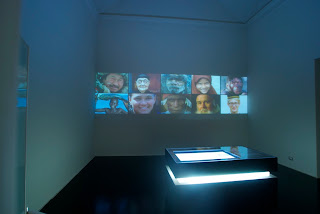The digitization of finds, as we saw in a previous post, has both advantages and disadvantages from different points of view. Leaving aside problems related to the economic sphere of the possible beneficiaries of their business (in the broadest sense), it is clear, however, that the technology that concerns the digitization has legitimized their use to a wider audience.
An audience that otherwise, perhaps by choice or particular socio-cultural conditions, would not get in touch with the same finds and, in return, to the sciences that study them.
The museum exhibitions and the educational exhibits are among the main beneficiaries of this new approach. It's a fact that an exhibition like Homo sapiens, which was held recently in Rome, would not have had the same impact on visitors if it had not made use of multimedia and interactive tools of a certain importance.
It is not just to amaze the visitor, but to help him to obtain, from its interaction with the exhibition, a real experience of the visit. Without this experience, in fact, hardly the visitor will reflect deeply on what he has seen and he will not derive useful advantage to his daily life. An advantage represented by an idea to be applied in his field of work, rather than the sheer relief given by the experience of beauty / interesting aspect.
The exhibition "Homo sapiens" is an example that can be misleading if we think, in general, to the usefulness of these technologies in the museum context. An example misleading because of the large investments and of spaces that were not the common ones.
Collaborating with local museums, I often deal with problems of exposure of the findings. The scarcity of economic resources that small museums often have to deal with and that basically is inherent to the very idea of a small museum (economic crisis or not) does not allow "easy" solutions that often coincide with high costs.
I recently reflected upon the relationship between technology and costs of the exhibitions, when I thought to the use of dioramas for a particular museum. The construction of models, when there is the possibility, is entrusted to specialized firms, sometimes to skilled artisans, more often to willing people who deal with it as a hobby and have a certain skill.
In this process, the technology is almost zero: the digitization and prototyping of models do not seem to be one of the basic tools to simplify the work of mounting. However, their potential is evident and the costs are relatively affordable, although it is to recognize that there is an objective problem of dissemination of this knowledge, which seem yet cabalistic material for the initiated few.
Build a diorama using rapid prototyping allows a considerable saving of time and costs, in addition to providing the basic material for the merchandising of a museum. If there is indeed a product segment that captures the imagination of the visitor is the object able to represent the visit just completed and that reminds him of the physical place where the visit took place (I omit here the anthropology of souvenirs which plays, however, its important part in this (re)cognition).
It's true that this process happens if the visit becomes experience and, therefore, as mentioned above, the visitor feels that he has acquired / purchased something applicable in other contexts. Therefore it's necessary, beyond the technological tools to be used, not forget that the visitor is at the center of everything, and that the finds in itself is only a means to educate him. “Education”, here, is not only the assimilation of information, but the opening of a new feeling about the topics covered.
So, without a good idea, the technology amazes without creating surprising experience, but without technology a good idea turns into a sterile list of information on a wall panel.
The link between idea and technology is in the experimental use (again, experience is the main part of the learning process and application) of the tools available, in a feedback process that goes from the idea to technology and vice versa. That is what has been experienced by our hominid ancestors with the feedback circuit formed by hand and brain, which created the language and has allowed both the biological and cultural evolution.
And the exhibits, in a certain way, are nothing more than a continuation of this process.


I'm glad you talk about prototyping and dioramas. Surely is one way to go in a near future, reducing production costs and simplify the modeling of complex objects. I'm also pretty sure that prototyping can also be an advantage to conservation-restoration professionals, allowing to create better casts, to fill gaps, or better exhibition supports for very broken artifacts.
ReplyDeletergaidao
Nice post! I was just two days ago in the Deutsches Museum in Munich (http://www.deutsches-museum.de/) and the dioramas were simply amazing!
ReplyDeleteRapid prototyping and Augmented Reality seems to be a good chance for museums and expositions. We will go on experimenting with these things!